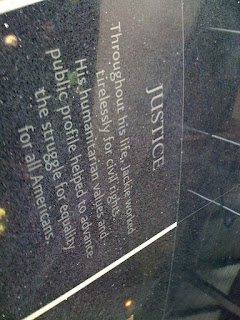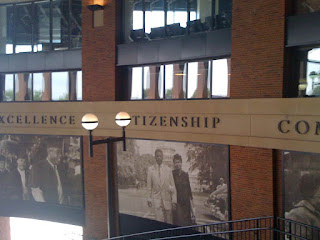I went down mid-game and was able to have the Jackie Robinson rotunda to myself.
You almost never see the 42 without someone taking a picture in front of it.
These are part of the floor. Usually you can’t read them because the area is crowded (that’s not a nitpick, just stating fact.)
Baseball should schedule the Dodgers at Citi Field every April 15th, and the Dodgers should wear classic Brooklyn throwbacks with the B hats. (That they didn’t do that for the first JR night was weird, especially because they wore throwbacks for a game against the Devil Rays.)
 Would it be a burden on the Dodgers to come east every year? Yeah it would, but they are the one’s who wanted to move to California. Their choice. This could be their home park if they stayed.
Would it be a burden on the Dodgers to come east every year? Yeah it would, but they are the one’s who wanted to move to California. Their choice. This could be their home park if they stayed.
Main Mets Police page
Follow us on twitter @metspolice
Facebook page
send ideas/guest columns to shannon at metspolice.com










As to your statement that this could be their home park if they'd stayed, it's quite likely that if the O'Malley's had gotten their way, there never would have been a ballpark in Flushing. I highly recommend reading "The Last Good Season," by Michael Shapiro, which covers the '56 Dodgers in great detail, including what was happening on the field, the negotiations behind the scenes that led to the announcement of the move to LA, and in and around Brooklyn that led to the drive to move out of Ebbets Field in the first place.
The O'Malleys originally conceived of LA as a bluff to force Robert Moses to give in to what the team really wanted. Ebbets Field was aging, and they felt that the team needed a new ballpark. At the same time, much of the fan base was moving to Long Island. O'Malley wanted to build a modern ballpark above the Atlantic Yards in Brooklyn (exactly where Bruce Ratner is now struggling to build an arena for the Nets), arguing that the easy access to both the LIRR and the subway would guarantee that large numbers of fans would be able to easily flock to the ballpark for years to come. Robert Moses agreed that they needed a new ballpark, but insisted that it had to be built just off the Grand Central Parkway, where Shea was eventually built, because it was highway access that was more important than transit access.
The book also talks about how the Dodgers were starting to experiment with other revenue streams, like a primitive form of pay television to allow the team to get more revenue from fans watching at home.
Had the Dodgers stayed, their ballpark wouldn't have been like Shea (which was all about being a Robert Moses style edifice), but would have been designed with the needs of a ballclub in mind, much as the ballpark the Dodgers ended up building in LA turned out to be. Remember that no one is talking about the imminent need to replace Dodger Stadium…